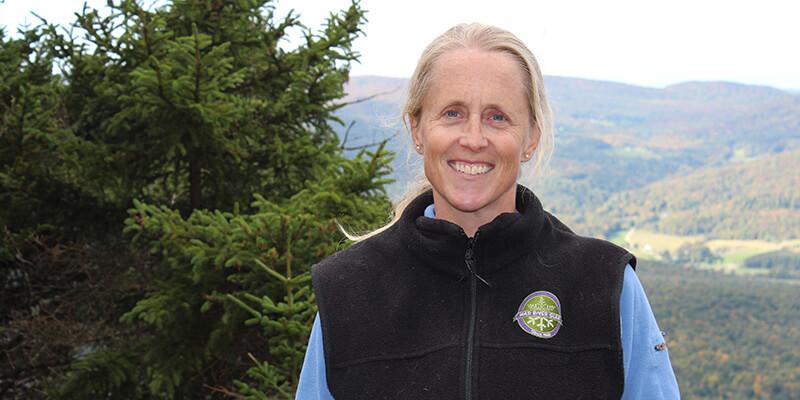Margaret Fowle (MS-WFB ’97) is a conservation biologist at Audubon Vermont, the state office for the National Audubon Society, in Huntington, Vermont. She manages peregrine falcon and bald eagle recovery and monitoring programs in Vermont and an initiative to enhance grassland and shrubland habitat for priority birds in the Champlain Valley.
With an undergraduate degree in studio art from Brown University, Margaret began her career working with birds quite serendipitously. Always interested in wildlife, she searched for a job in that field after college. She was lucky to find one at the Vermont Institute of Natural Science (VINS) in Woodstock, Vermont in their raptor center. After several years caring for injured raptors, she decided to turn her attention to birds in the wild. She contacted Professor (now Emeritus) David Capen in the then UVM School of Natural Resources and enrolled in the Master’s program in Wildlife and Fisheries Biology.
Margaret’s thesis project took her to Young Island in northern Lake Champlain where she investigated exploding populations of double-crested cormorant in the mid-1990s. In collaboration with the state of Vermont Department of Fish and Wildlife and the Vermont Cooperative Fish and Wildlife Research Unit in the School, she counted nests and young birds on the island, collected regurgitated fish to identify in the lab, and used a computer energetics model to estimate cormorant population size and growth.
She discovered that young cormorants were eating predominately yellow perch, the most abundant non-game fish in the lake. Her findings had direct application to the state’s quest to learn more about the ecological and economic impacts of the cormorants. Since then, Vermont Fish and Wildlife has successfully lowered cormorant populations on Lake Champlain and removed them from Young Island.
“Through Dave Capen and my M.S. work and experience, I made valuable connections in the state and found employment in my field,” acknowledges Margaret. “I gained field, ornithology, and GIS skills that I apply in my current job every day.”
After graduating from UVM in 1997, Margaret returned to VINS as a part-time peregrine biologist. With very few peregrine falcon breeding pairs in the state at that time, she monitored populations, evaluated management needs at each cliff nesting site, implemented protection measures if necessary, and supervised banding of young falcons for future monitoring. She collaborated with private and public landowners, coordinated and trained volunteers, and educated the public.
She soon combined her job at VINS with a full-time position at the National Wildlife Federation in Montpelier, Vermont where she continued to manage the peregrine recovery program, work with citizen volunteers, and coordinate with various partner organizations. She also initiated a bald eagle recovery project for the state and managed the Lake Champlain translocation of nearly 30 young eagles to Addison, Vermont and subsequent monitoring of the birds.
In 2009, Margaret took her current position with Audubon Vermont, where she continues to coordinate peregrine monitoring and assists with bald eagle recovery programs in Vermont. As part of the Vermont Peregrine Falcon Program, she supervises 40 citizen volunteers, who do much of the on-the-ground nest site monitoring, while Margaret tackles the harder to reach nesting sites.
She tracks peregrine populations and determines which nesting sites to close off from hiking and rock climbing during the spring and early summer breeding season. Margaret is excited to report that at least 50 breeding pairs of peregrine falcons now nest in Vermont, a new record this year.
“The peregrine population on the entire eastern coast was down to zero by the late 1960s from use of the pesticide DDT,” Margaret explains. “In the early 1980s, birds were released once again in Vermont at three different sites, and it is great to be a part of this successful recovery of such a majestic species in the state.”
She partners with Vermont Fish and Wildlife to establish monitoring and management protocols for peregrine falcons, secure grant funding for the program, and work with cooperating landowners.
Margaret also works with Vermont Fish and Wildlife to recover bald eagles in Vermont. She drafted the state bald eagle recovery plan, conducts the Winter Bald Eagle Survey, initiated in the 1970s and 80s, coordinates volunteer citizen monitors, and teams up with New Hampshire Audubon to monitor eagles in the Connecticut River Valley.
As part of Audubon’s Champlain Valley Bird Initiative, Margaret collaborates with landowners to enhance habitat for priority grassland and shrubland birds. She assesses the habitat and works with the landowner to structure management of the habitat to improve nesting success for birds of interest, such as the golden-winged warbler, a rapidly declining shrubland species and a candidate for federal endangered listing.
A big partner in this initiative is Vermont Electric Power Company (VELCO) of Rutland, Vermont. Margaret cooperates with VELCO to survey powerline rights-of-way for priority shrubland birds. In conjunction with Rubenstein School Associate Professor Allan Strong and former graduate student Christine Peterson (MS-WFB ’14), Margaret assisted VELCO in developing bird-friendly management techniques to enhance shrubland habitat in rights-of-way and beyond with participation from adjacent private property owners. Margaret and Audubon Vermont inform landowners about cost-sharing opportunities for habitat improvement available through the Natural Resources Conservation Service (NRCS).
Margaret has also partnered with Allan and many Vermont farmers to improve nesting success of declining bobolinks in agricultural grasslands of the Champlain Valley.
She makes her home in Huntington with her husband Breck Knauft, who is the interim director at the Vermont Youth Conservation Corps, and their daughters Ada and Frances. The family enjoys hiking, skiing, biking, and gardening and maybe just a little birding.
